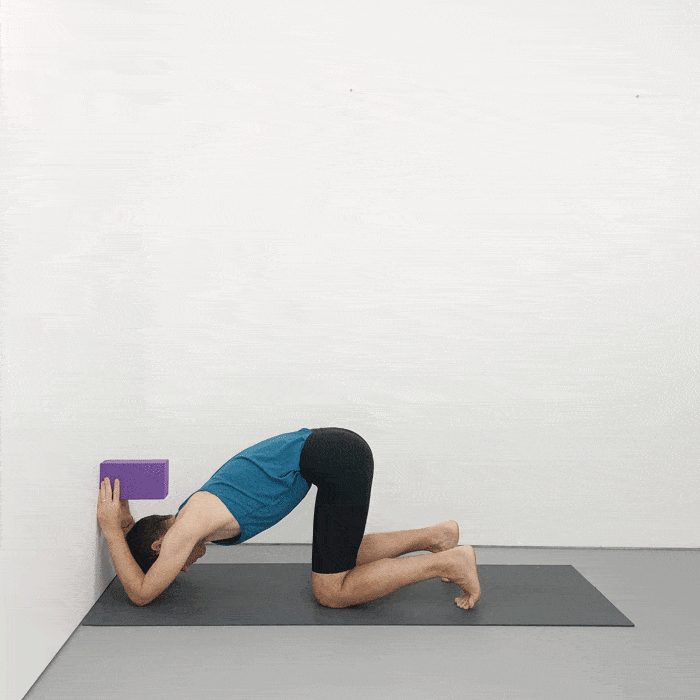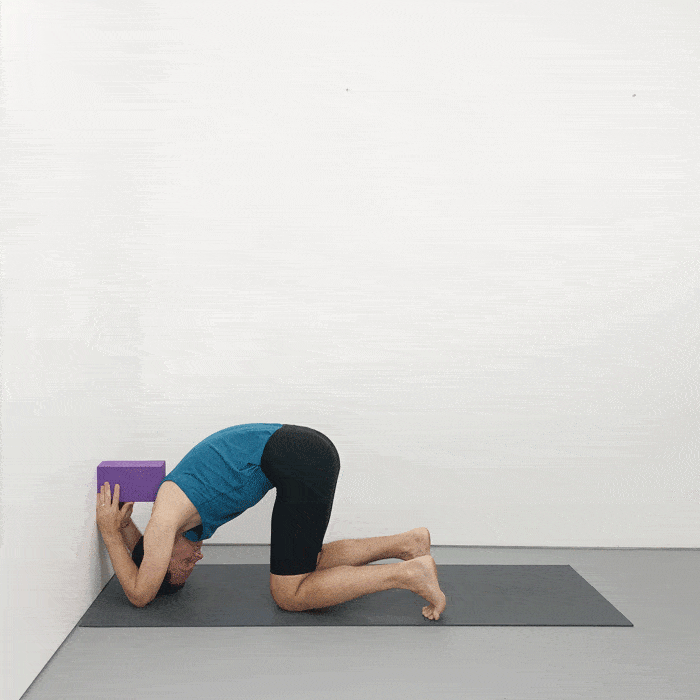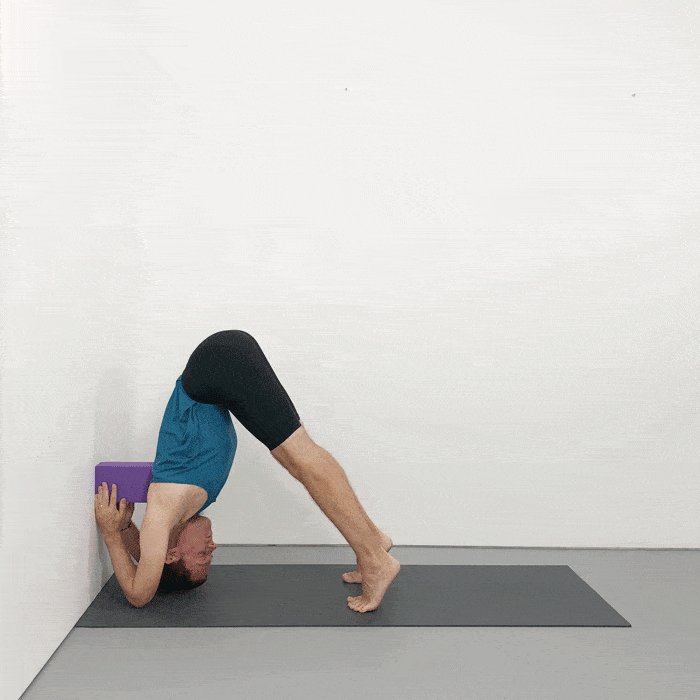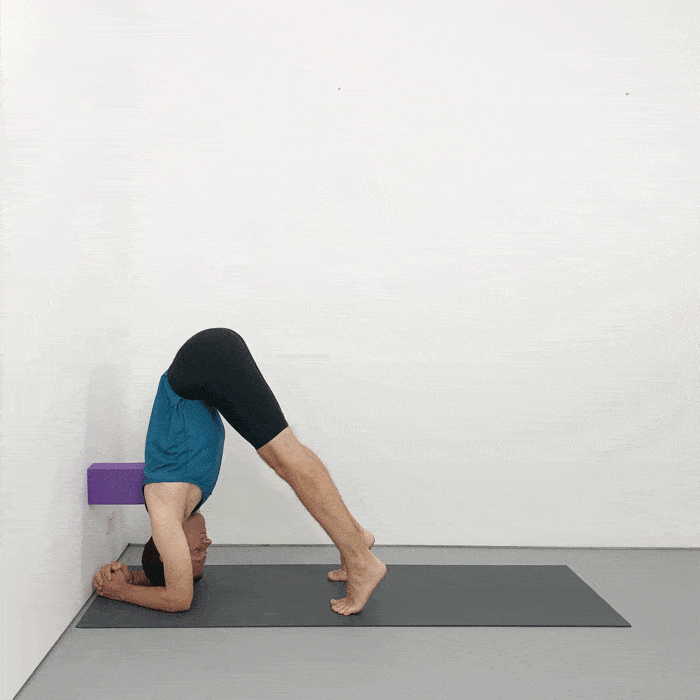Iyengar yoga has an array of preparatory poses that will help you to build a strong foundation when learning how to do sirsasana (headstand). Before progressing to the stage of actually standing on your head, it is important that you have acquired the strength necessary to support your body weight in an upside down position. It is also vital that you have learned preliminary techniques that help to protect against the risk of injuring your neck. This process of learning and strengthening cannot be rushed. For most students a period of several months will be devoted to cultivating a healthy headstand foundation.
This post explores one of the more important of the headstand preparation poses. It involves the placement of a block between your upper back and a wall. This pose teaches the arm action of a full headstand without any weight being placed on the top of your head. It also helps you to build the strength necessary for a full headstand without your neck being placed in a vulnerable position. For many people it is also a confidence building pose, enabling them to gradually build familiarity with a more upside down orientation. Unfortunately it is also a pose that commonly requires the presence of a teacher to assist with positioning of the block. For this reason it is often left out of a home yoga practice. This blog looks to address this problem and show an easy to follow method for independently working at home with this fundamental pose.

Stage 1. The key to being able to place the block in position yourself is knowing how far your elbows need to be from the wall. They need to be close to the wall; around 10 cm away from the wall.
- Hold a foam yoga block between both sets of fingertips.
- Whilst kneeling, position both elbows 10cm away from a wall.
- Ensure that your elbows are shoulder width apart.
- Keep you head low down near the floor. (You will not be able to see the block with your eyes.)
- Once your elbows are positioned, hold the block securely against the wall with your fingertips.

Stage 2. Keeping your elbows in this position, and securing the block with your hands you now raise your upper back to make contact with the block.
- Whilst still kneeling, raise your upper back towards the block.
- Bring your upper back into contact with the block.
- The part of the back that touches the block is your upper thoracic. It is a little further back than the C7 bone at the base of your neck, in the region where your shoulder blades are positioned.
- Bring as much of your back as possible into contact with the block.

Stage 3. With your upper back and fingers holding the block in position you are now ready to straighten your legs.
- Whilst securing the block to the wall with your fingers and upper back, straighten your legs and lift your pelvis upwards.
- As your legs straighten lift your heels as high as possible, and walk your toes closer to your elbows.
- Observe how lifting your heels higher helps to lift your pelvis higher.
- Ensure that no part of your head is in contact with the floor.

Stage 4. You are now ready to bring your hands down to the floor.
- Keeping one hand to the block, sweep the other hand off the block and down to the floor. (This is a dynamic movement)
- Press the outer waist of this arm firmly into the floor once it is down.
- Now sweep the second hand down and interlock your fingers with your knuckles touching the wall.
- Ensure that your elbows are directly under your shoulders.
- Check that your fingers are interlocked all the way to their bases
- Eventually in headstand your hands make a cup shape, but for now keep the heels of your hands close together so you can concentrate on pressing your wrists and forearms down.
- Press your forearms down and lift your shoulders, spine and hips upwards.
- Press your forearms down and lift your thigh creases upwards.
- Lift your heels and walk in closer with your feet.
- Your neck can now relax, but ensure that your head remains off the floor.
- To release out of the pose, simply bend your knees and let the block drop down.
- This pose is featured in our Weekly Intermediate Class 57. This video can be found in the Weekly Classes section of yogaselection.com.
Sirsasana (headstand) is one of the cornerstones of an Iyengar yoga practice. Knowledge of its importance, can potentially lead towards rushing the process of learning the pose. It is crucial to ensure that an adequate preparatory process has taken place prior to attempting the full pose. This might take weeks to months and involves ensuring there is enough strength and mobility in the thoracic spine and shoulders to support the head and neck in a weight-bearing position. The preparatory pose demonstrated in this post is a valuable tool that can be used as a stepping stone towards the safe practice of Sirsasana.
Learn Iyengar yoga online with expert guidance.
Stream unlimited Yoga Selection classes and build a home practice that gets results.
Try it free for 14 days. Cancel anytime.

Comments 1
Rod,
This feels great. How long should I hold pose?